AMD Radeon R9 390X and 390 review: Hawaii rebooted
Same same but different
The top-end of AMD’s new 300-series of graphics cards just got a lot more interesting. AMD has broken precedent with its 200-series cards, and the Radeon R9 390X and 390 no longer comprise the best of what AMD has to offer in 2015. If you’re reading this review, you probably already know that the crowning jewel of AMD’s 2015 graphics card line-up is the newly-coined AMD Radeon R9 Fury X.
You’re probably wondering ‒ how could that make the R9 390X and 390 more interesting?
Let’s just say that by offering a new flagship under a new name and upgrading its existing line-up of cards, AMD has created a more diverse product portfolio. The Radeon R9 Fury X and Fury are without doubt the cards enthusiasts will look to when they want the very best from AMD, but these consumers comprise the minority of the overall graphics card market.
The majority of consumers instead seek to find a balance between performance and value, and the Radeon R9 390X and 390’s entrance into the upper-end of the mainstream graphics card market could be a boon to consumers looking for performance, but don’t necessarily want to absolute best.
This is helped along by the lower launch price of both cards. While the Radeon R9 290X and 290 were originally launched at US$549 and US$399 respectively, this year’s Radeon R9 390X and 390 come in at just US$429 and US$329 each.
Note that we also mentioned that AMD has upgraded, rather than replaced its 200-series of cards. That’s because like the Radeon R9 380 and R7 370 below it, the Radeon R9 390X and 390 are essentially rebadges of last year’s 200-series cards.
The Radeon R9 290X and 290 saw AMD debut its new Hawaii GPU architecture, which AMD has returned to on the R9 390X and 390. It’s slightly disappointing that AMD has nothing new to offer below the top-end Fury X, but we suppose the lower price somewhat makes up for it.
What’s in a name?
That which we call a rose, by any other name would smell as sweet. We see a return to Hawaii on the R9 390X and 390, but AMD has decided to rename the architecture to Grenada XT. But despite the spanking new name, the new cards are still very much Hawaii GPUs at heart.
The biggest changes when compared to the Radeon R9 290X and 290 come in the form of higher core and memory clocks (thanks to a mature GPU design, but it may impact the overclocking headroom) and an impressive 8GB of GDDR5 memory. Between the two cards, the differences can be narrowed down to the number of Compute Units (CU) enabled per Shader Engine and the core clock speeds.
Here’s a look at the block diagram for the Radeon R9 390X:
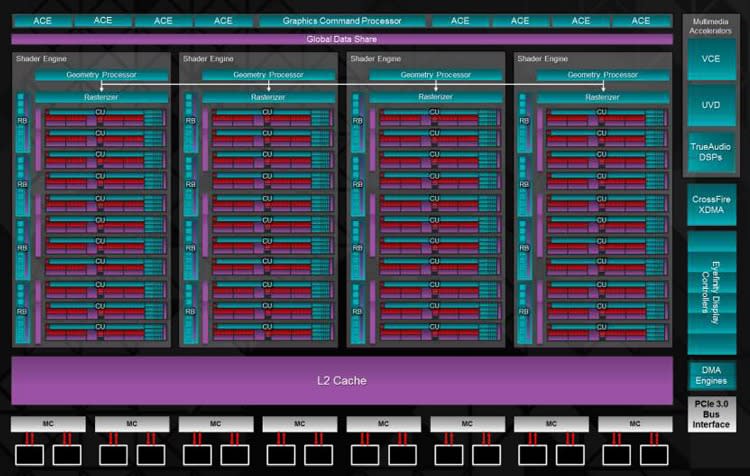
The Radeon R9 390X has 11 CUs enabled per Shader Engine, for a total of 44. On the other hand, the R9 390 retains the four Shader Engines but has just 40 CUs because one is disabled in each Shader Engine.
The number of stream processors also remains unchanged from the 290 series, with the R9 390X featuring 2816 stream processors and the R9 390 a more modest 2560.
You could say that AMD has taken the easy way out and simply ramped up clock speeds to improve performance over last year’s cards. In comparison to the reference clock of 1000MHz on the Radeon R9 290X, the Radeon R9 390X sports a 1050MHz core clock. Similarly, the Radeon R9 290’s reference clock of 947MHz has been bumped up to 1000MHz on the Radeon R9 390.
In addition, memory clock speeds have been increased from 5000MHz to 6000MHz, equivalent to a sizeable 20% boost over the previous generation. AMD made a conscious decision on the original Hawaii GPU to stick to wide and slow memory controllers in order to maintain better power consumption figures. However, it has abandoned this entirely now by ramping up the memory clock speeds by quite a significant amount, consequently increasing the available memory bandwidth on both cards to 384GB/s, compared to 320GB/s previously.
This is actually quite a lot of bandwidth to work with. To put things in perspective, the NVIDIA GeForce GTX Titan X – the undisputed single-GPU performance champion – has just 336.5GB/s of memory bandwidth. At 384GB/s, the Radeon R9 390 series of cards have the highest memory bandwidth available to any GDDR5 graphics card today.
And when you consider that increasing numbers of gamers are demanding to play at resolutions exceeding 1080p, this may just give the new Radeon cards a leg up in situations where the lack of memory bandwidth could potentially hurt performance.
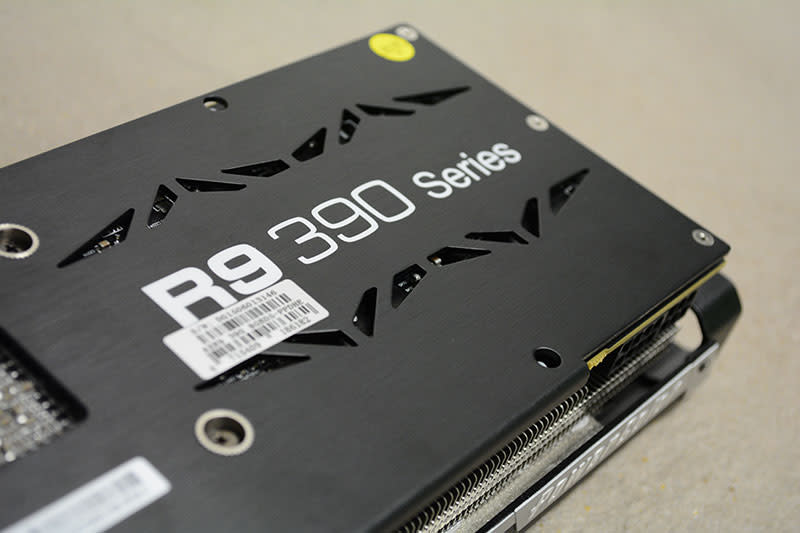
Furthermore, the onboard 8GB of GDDR5 memory makes the card look good beside competing NVIDIA cards, on paper at least. For instance, the only card to have more GDDR5 memory is the 12GB GeForce GTX Titan X. In comparison, the GeForce GTX 980 has 4GB of memory, and even the GeForce GTX 980 Ti has only 6GB.
According to PC World, AMD also said that the Radeon R9 390X and 390 are not merely juiced up versions of the R9 290 series cards, and in fact feature improvements to power management and efficiency. Incidentally, the 290 series cards have indeed received a lot of flak for their high power consumption (which can be as high as 400 watts), especially when compared against NVIDIA’s second-generation Maxwell cards.
However, both the Radeon R9 390X and 390 have a Thermal Design Power (TDP) of 275 watts, which is the same as that of the Fury X. And as we’ll see in our power consumption tests later, total power consumption hasn’t exactly gone down – in fact, it’s gone up. As a result, when AMD talked about better power efficiency, it might have been referring to less overt metrics like performance-per-watt.
In addition, AMD has reportedly told AnandTech that it is now using 4Gb GDDR5 chips in the 390 series cards, as opposed to 2Gb chips in the 290 series. These chips have better timings and operate at lower voltages than the 2Gb variants, which supposedly helps to reduce power and allow the 20% increase in memory clock speeds.
Nevertheless, we remain skeptical as to how much of a change ‒ or rather a change that end users will notice ‒ AMD can effectively bring about in the card’s power profile, seeing as both R9 390 cards are still based on the same Hawaii GPU architecture as their predecessors.
We’ll take a closer look at the design of the cards in the following sections. AMD hasn’t provided us with any reference samples, so we’re using the MSI Radeon R9 390X Gaming 8G and PowerColor PCS+ Radeon R9 390 to get an idea of what AMD’s new cards are capable of.
MSI Radeon R9 390X Gaming 8G
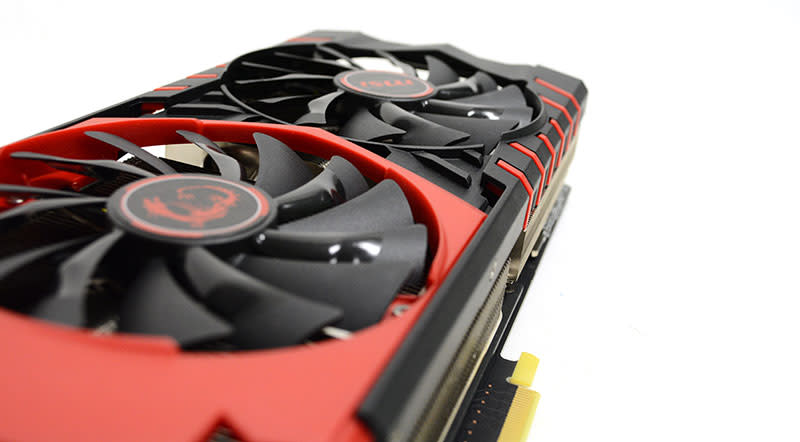
The MSI Radeon R9 390X Gaming 8G hews close to the design we’re used to seeing on most cards with MSI’s excellent Twin Frozr V cooler. The dual-fan cooler has consistently managed to beat out other triple-fan offerings in our tests with other cards, and it is one of the better air-cooling solutions available right now.
The dual Torx fans are also able to operate independently, allowing the card finer control over noise and cooling performance.
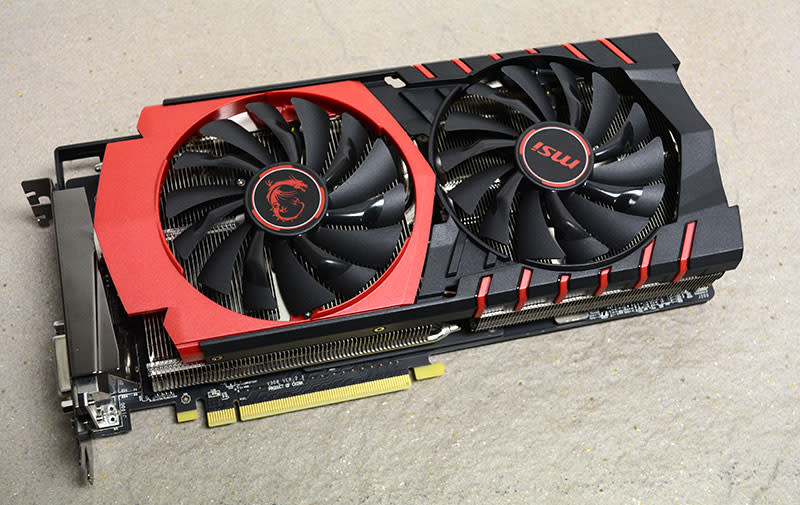
MSI has included a sturdy metal backplate adorned with the MSI dragon insignia. This protects the card’s PCB and provides structural support against flexing.
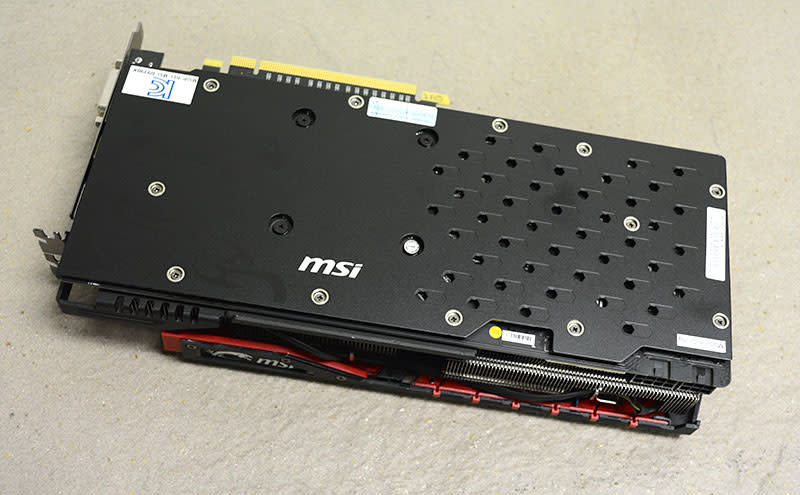
The card ships out of the box in Gaming mode, with a core clock of 1080MHz and effective memory clock of 6000MHz. This is a small 30MHz increase over AMD’s reference specifications for the core clock, with the memory clock remaining unchanged.
Here’s a quick look at the card’s out-of-the-box specifications:
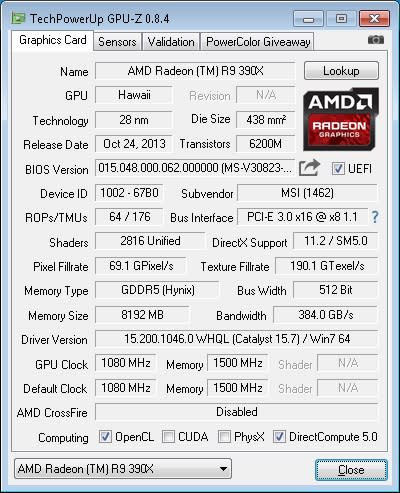
As per expectations, the card supports two other presets to cater to users’ preferences for either more performance or less noise. OC mode takes the core clock and memory clock up to 1100MHz and 6100MHz respectively, while Silent mode drops them down to 1050MHz and 6000MHz.
Like the Radeon R9 290X before it, the Radeon R9 390X sports two dual-link DVI-D ports, one HDMI port, and one DisplayPort connector. This is different from the triple DisplayPort outputs we’ve gotten used to seeing on NVIDIA’s high-end cards. The Radeon R9 Fury X even dispenses with DVI ports entirely.
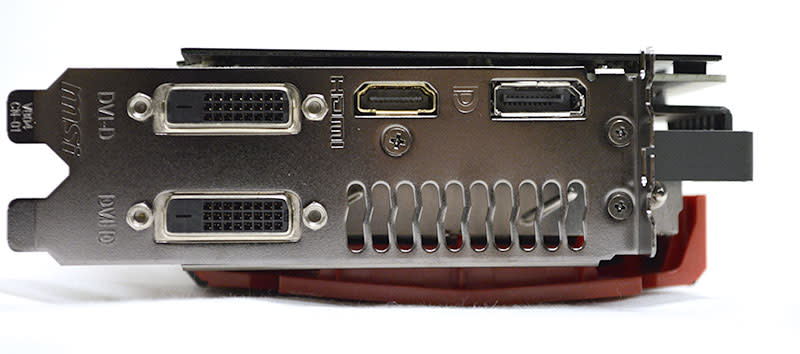
Power is delivered via one 6-pin and one 8-pin PCIe power connector, the same as AMD’s reference design.
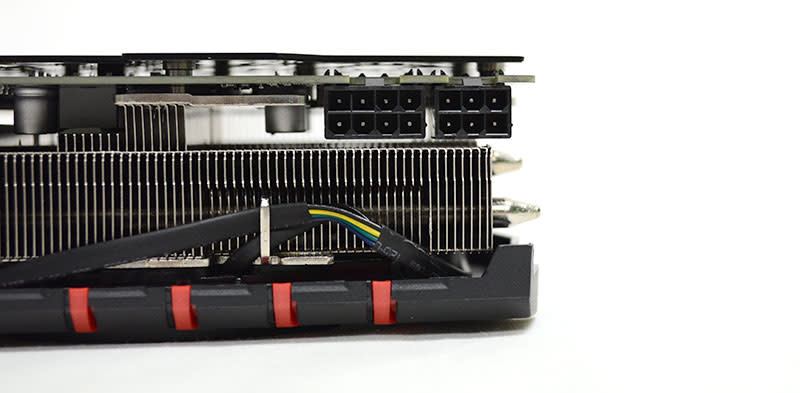
Finally, for a feature that doesn’t really add any utility to the card – the ability to add custom lighting effects to the MSI Gaming dragon insignia at the card’s side. There isn’t a whole lot of choice, but users can choose options like “Breathing” or “Flashing” in the MSI Gaming App.
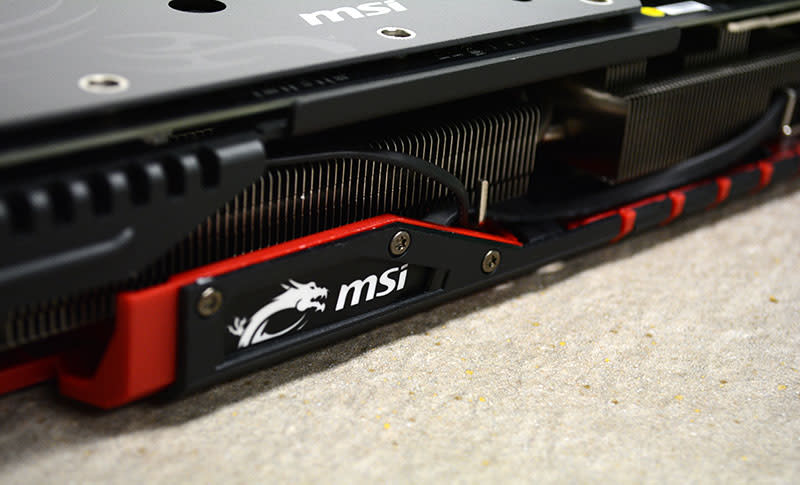
PowerColor PCS+ R9 390
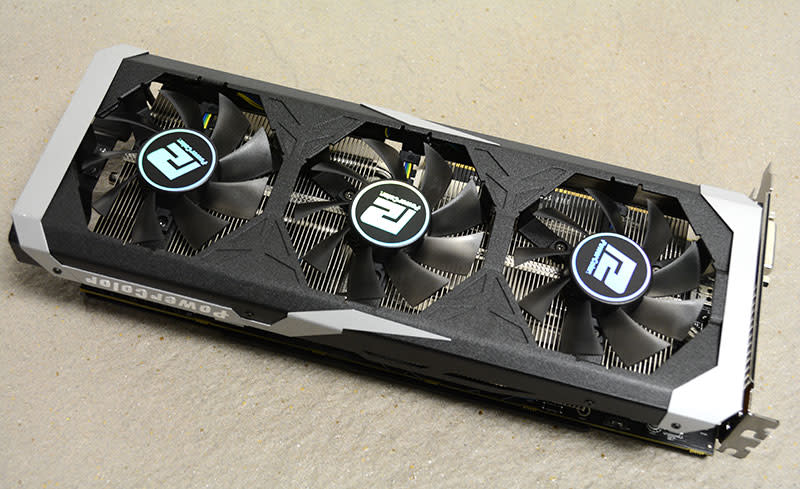
The PowerColor PCS+ R9 390 utilizes a triple-fan custom cooler to cool the Hawaii GPU underneath. Unlike the MSI card, the color scheme is fairly nondescript, being mostly black with slight accents of silver at the edges.
And as is the case with many custom cards from add-in manufacturers these days, the card features a solid metal backplate for extra support and to protect the PCB.
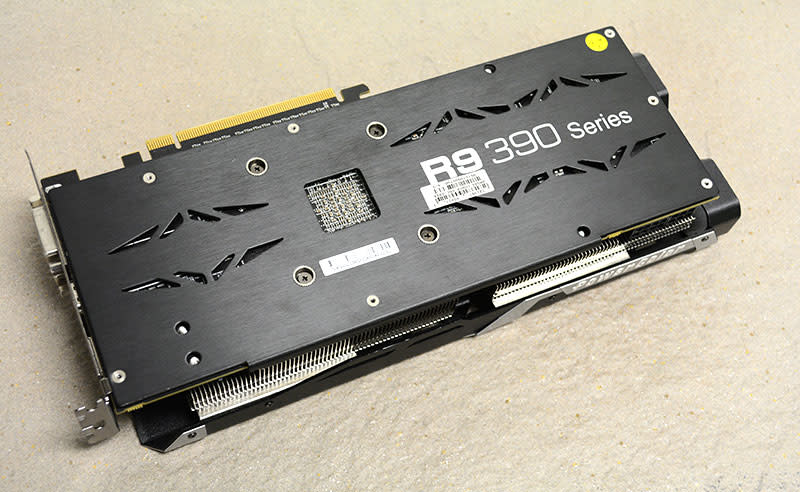
The card is clocked at a 1010MHz core clock and 6000MHz effective memory clock, representing just a tiny speed bump over the 1000MHz reference core clock.
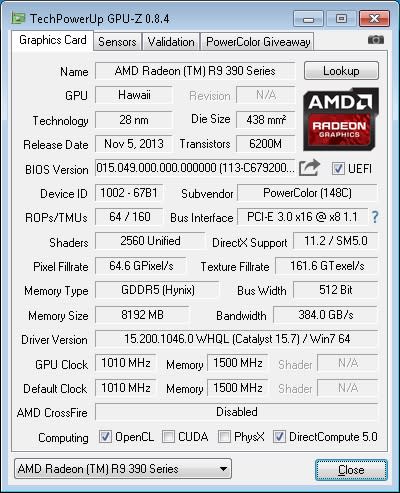
Round the back of the card, it features two DVI-D ports, one DisplayPort connector, and one HDMI output just like the R9 390X.
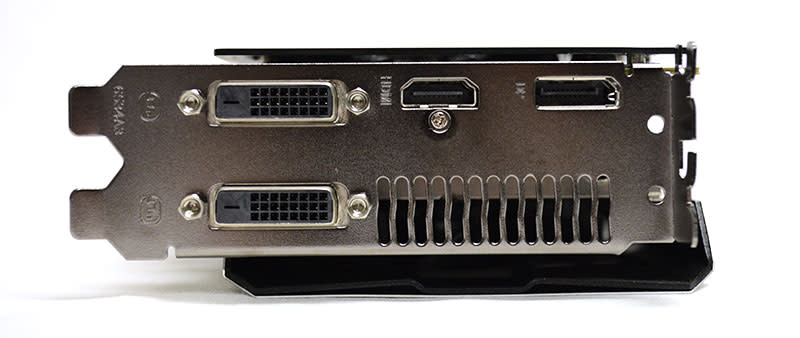
And like the reference card, the PowerColor PCS+ R9 390 is also powered by one 6-pin and one 8-pin PCIe connector.
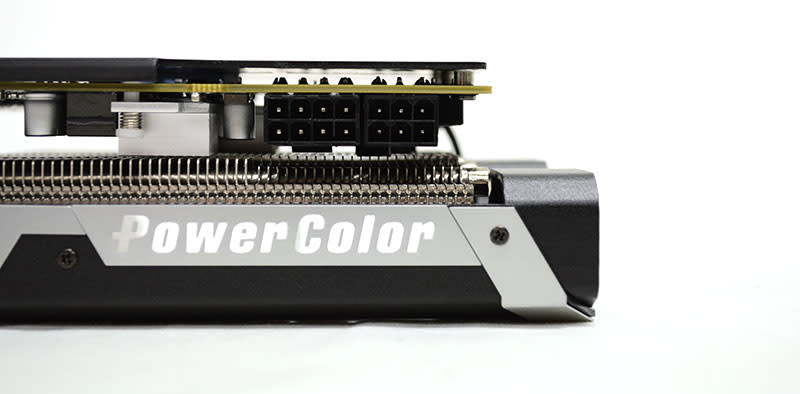
Test Setup
Here are the specifications of our graphics testbed:
Intel Core i7-5960X
ASUS X99-Deluxe (Intel X99 chipset) motherboard
4 x 4GB Corsair Vengeance LPX DDRR-2133 (Auto timings: CAS 15-15-15-36)
Samsung 840 Pro 256GB SSD (OS)
Western Digital Caviar Black 1TB (Benchmarks + Games)
Windows 7 Ultimate 64-bit SP1
Intel INF 10.0.20
In order to see where the Radeon R9 390X and 390 stand, we’ve decided to pit it against the Radeon R9 290X, the NVIDIA GeForce GTX 980 and 970. The R9 290X and GeForce GTX 980 are obvious competitors to the R9 390X, while the GeForce GTX 970 will go up against the R9 390. Unfortunately, we don’t have an R9 290 card with us at this time, so we’re unable to add it to our comparisons.
Below is a full list of the cards and their driver versions:
MSI Radeon R9 390X Gaming 8G (AMD Catalyst 15.7)
PowerColor PCS+ R9 390 (AMD Catalyst 15.7)
ASUS Radeon R9 290X DirectCU II (AMD Catalyst 15.7)
Gigabyte GeForce GTX 980 G1 Gaming (ForceWare 353.30)
Palit GeForce GTX 970 JetStream (ForceWare 353.30)
Do note that we’ve updated our system with the new AMD Catalyst 15.7 drivers, which finally unite the Radeon R9 300 and 200 series under the same driver build. Catalyst 15.7 also reportedly offers performance improvements in Tomb Raider, so these results should show the latest performance figures at the time of writing.
Benchmarks
As per our practice when doing initial reviews of new cards, we’ll be putting both cards through our full suite of synthetic and real-world gaming benchmarks:
Futuremark 3DMark 2013
Middle-earth: Shadow of Mordor
Crysis 3
Tomb Raider
Hitman: Absolution
Thief
For our temperature and power consumption tests, we used the Fire Strike Extreme benchmark in 3DMark 2013.
We’ve also compiled a table to show how the cards stack up against one another on paper:
Performance Results
3DMark 2013
The Gigabyte GeForce GTX 980 G1 Gaming topped the charts here, coming in at just over 8% faster than the MSI Radeon R9 390X Gaming 8G in Fire Strike. On the other hand, the PowerColor PCS+ Radeon R9 390 just managed to edge out its direct competitor, the GeForce GTX 970, by less than 1%.
In turn, the Radeon R9 390X was on average around 8% faster than the R9 290X, a modest gain that’s to be expected given that there have been no fundamental changes save for a few tweaks and speed boosts here and there. The Radeon R9 390 also turned out to be more or less on par with the Radeon R9 290X, so AMD has at least succeeded in bringing what was previously its enthusiast-level performance to a card priced more for the mainstream.
When moving up to the more demanding Fire Strike Extreme (running at 2,560 x 1,440 pixels resolution) and Ultra (3,840 x 2,160 pixels resolution) tests, the performance difference between the GeForce GTX 980 and the Radeon R9 390X widened to around 14%. Nevertheless, these are just synthetic benchmarks, and we’ll refrain from jumping to any hasty conclusions that AMD is failing to live up to its claims of performance at high resolutions.

Middle-earth: Shadow of Mordor
Happily enough for AMD, there is a positive turnaround in Middle-earth: Shadow of Mordor. We ran the game on Ultra settings (the highest available) with HD Textures enabled, setting it up to devour quite a bit of video memory.
Both the R9 390X and R9 390 perform well here, with the 390X beating all the other cards at all our tested resolutions. The 8GB of GDDR5 memory, higher memory clock speeds, and the 384GB/s of memory bandwidth is clearly coming in handy here. To help quantify things, the R9 390X was almost 11% faster than the Gigabyte GeForce GTX 980 G1 Gaming at a resolution of 2,560 x 1,600 pixels. At 224GB/s, the memory bandwidth of the GeForce GTX 980 is actually quite lacking compared to the 384GB/s available to the 390 series cards.
The R9 390 also fared well against the GeForce GTX 970, where it was 19% faster than the latter card when testing at 2560 x 1600.
At least in Shadow of Mordor, AMD’s strategy to boost high-resolution gaming performance by increasing memory bandwidth appears to have paid off.

Crysis 3
In Crysis 3, things return to what we observed in 3DMark 2013. The GeForce GTX 980 card came in first in all our tested settings. The difference was most pronounced at a resolution of 1,920 x 1,200 pixels with anti-aliasing turned off, where the NVIDIA card was just under 14% faster than the R9 390X.
The gap does close a fair bit at higher resolutions and with 8x MSAA turned on, likely owing to the generous amount of memory bandwidth available to the 390 series cards.
The R9 390 was again nearly indistinguishable from the R9 290X, and both cards trailed the GeForce GTX 970 by a small margin. It’s really testament to the strength of NVIDIA’s second-generation Maxwell cards that the GeForce GTX 970 can continue to remain competitive against AMD’s latest gambit.

Tomb Raider
The same story repeats itself in Tomb Raider, but with one key difference – the R9 390X actually loses out to the GeForce GTX 970 at both tested resolutions.
This reminds us of what we observed in our review of the Fury X, where the most memory-hungry scenarios were required to help it close the gap with NVIDIA’s flagship cards. The Fury X and the 390 series cards both have the luxury of memory bandwidth – even if they utilize different memory architectures – and it looks like Tomb Raider simply isn’t demanding enough to bring out the best in them.
It’s again worth noting that the R9 390 and R9 290X were still neck-and-neck, and the R9 390 is certainly shaping up as the card to force the 290X into retirement.

Hitman: Absolution
The GeForce GTX 980 raced ahead at the resolution of 1,920 x 1,200 pixels with anti-aliasing turned off. Moving on to more demanding resolutions and settings, we’re really seeing a repeat of what we saw with the Fury X. AMD’s 390 series of cards also need memory-hungry applications to do well, and the company is probably right in framing high-resolution gaming performance as one of the card’s advantages.
At a resolution of 2,560 x 1,600 pixels and above or with 8x AA enabled, the 390 series cards inched their way to near the top of the benchmarks, trailing only the more expensive GeForce GTX 980 by a small margin.

Thief
All three AMD cards were relatively closely matched in Thief. There were just a few frames of difference across all the cards at all our tested settings, a relatively minuscule difference that gamers would be hard-pressed to notice in-game. But unfortunately for the AMD cards, the cheaper Palit GeForce GTX 970 JetStream (S$479) edged ahead in all our tests but one.
At the most demanding resolution of 2,560 x 1,600 pixels and Very High settings, the Radeon R9 390 series cards look like they finally managed to get ahead of the Palit GeForce GTX 970 thanks to their excess memory bandwidth. It was also here that the R9 390X came within a few frames of the GeForce GTX 980’s performance.

Temperature and Power Consumption
Our temperature tests are conducted by looping 3DMark Fire Strike Extreme for 15 minutes and then checking the highest recorded temperature. The MSI Radeon R9 390X Gaming 8G and the ASUS Radeon R9 290X DCUII recorded the same peak temperature of 73℃, an unsurprising result given that they both use the same Hawaii GPU architecture.
The less powerful PowerColor PCS+ Radeon R9 390 ran cooler at 65℃, probably owing to its lower clock speeds and pared-down Hawaii core.
When it came to power consumption, the AMD cards showed why the Radeon R9 290 series cards have received so much criticism for their power management and efficiency. The R9 390X posted the highest peak power consumption – 417 watts – in 3DMark Fire Strike Extreme. In fact, power consumption increased over the Radeon R9 290X, so AMD clearly wasn’t talking about overall power consumption figures when it mentioned improvements to power efficiency.
Nevertheless, the increase is to be expected given the increase in core and memory clocks, and we’d be surprised if AMD actually managed to bring the overall figure down. Second-generation Maxwell also continues to shine in to power consumption department, and both NVIDIA cards rounded up the bottom of the charts in our power consumption test.

Overclocking
We managed to overclock the Radeon R9 390X to a core clock of 1130MHz and an effective memory clock of 6480MHz, representing just a 5% and 8% increase over stock speeds respectively. This ultimately isn’t a very impressive overclock, and it translated into an approximately 4% increase in all three 3DMark tests.
This is a marginally better performance as compared to the R9 290X, but ultimately, overclocking headroom isn’t something that AMD has managed to bring significant improvements on.
As for the Radeon R9 390, we managed to achieve an 80MHz overclock to 1090MHz core clock and 6400MHz effective memory clock. This resulted in just under a 6% gain in 3DMark 2013.
AMD’s overclocking performance was actually more or less on par with the GeForce GTX 970, which posted around a 6% gain when overclocked. However, the GeForce GTX 980’s overclocking capabilities proved unrivalled here, and it powered ahead to an approximately 10% increase in performance.

High-resolution gaming performance at a cheaper price
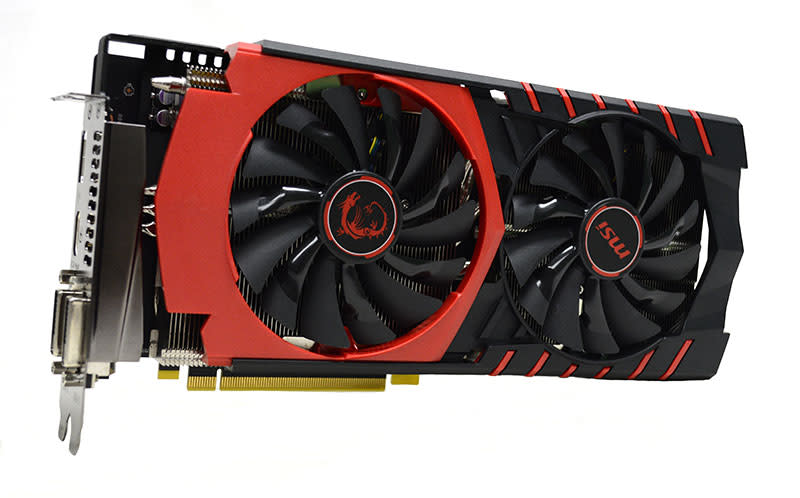
Ultimately, the strongest selling point of the Radeon R9 390 series of cards has to be the performance they deliver at high resolutions and memory-hungry rendering situations. Like the Fiji-based Radeon R9 Fury X, the R9 390X and 390 lose out to NVIDIA’s offerings in situations where memory bandwidth isn’t the limiting factor.
We were particularly impressed by the performance of the 390 series cards in Middle-earth: Shadow of Mordor, where it handily beat the Gigabyte GeForce GTX 980 G1 Gaming. The MSI Radeon R9 390X Gaming 8G and PowerColor PCS+ Radeon R9 390.
As the newest game in our graphics testing suite, Shadow of Mordor is the best indicator we have of the performance of the R9 390 series cards going forward. As newer and more demanding games require even more memory bandwidth, the 390 series cards could find themselves in a strong position going up against NVIDIA.
However, with older games and 1080p resolutions, the GeForce GTX 970 might just be a better bet. The Palit GeForce GTX 970, which is relatively cheaper, served up good performance that rivaled the 390 series cards quite often, only falling behind as resolutions and anti-aliasing settings ramp up.
As a result, the attractiveness of the Radeon R9 390X and 390 likely depends on what sort of games and settings you intend to play at. If you play mostly older titles at 1080p, we wouldn’t really recommend the 390 series since the GeForce GTX 970 performs better and is cheaper. However, if you hope to play games like Shadow of Mordor at resolutions exceeding 1080p, the 390 series is a sensible choice. In these scenarios, the performance advantage of the NVIDIA Geforce GTX 980 isn’t quite enough to warrant a S$200 price premium over the 390X.
Furthermore, we’d venture to say that the Radeon R9 390 offers the best value of all because of its palatable price and performance relative to the R9 390X and GeForce GTX 980. At a resolution of 2,560 x 1,600 pixels, it is consistently within a few frames of its bigger brother, the R9 390X. It is also around S$200 cheaper, so if you’re looking achieve playable frame rates on quad HD resolutions with the eye candy cranked up, you should definitely consider the R9 390. Note that we said a playable frame rates, so don’t be expecting to get over over 60fps.
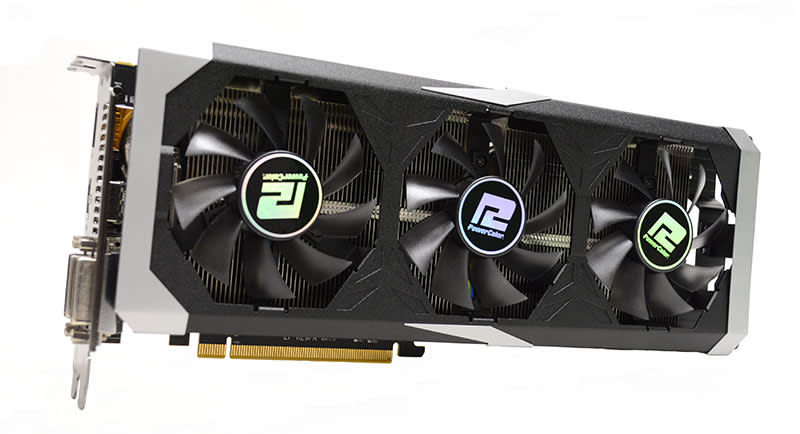
In sum, we actually quite like AMD’s R9 390 series. We came in skeptical about the merits of rebranding last year’s GPU architecture, but have come away quite convinced that these cards offer decent performance for the dollar in the segment of the market just below the GeForce GTX 980 Ti and the Fury X. As we move forward into realm of quad HD gaming and increasing memory bandwidth demands, AMD’s 390 series cards could be very meaningful contenders for consumers’ wallets.


